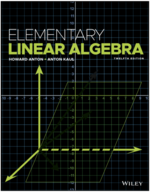?Let \(\boldsymbol{V}\) be the set of all ordered pairs of real numbers, and consider
Chapter 4, Problem 1(choose chapter or problem)
Let \(\boldsymbol{V}\) be the set of all ordered pairs of real numbers, and consider the following addition and scalar multiplication operations on \(\mathbf{u}=\left(u_{1}, u_{2}\right)\) and \(\mathbf{v}=\left(v_{1}, v_{2}\right)\):
\(\mathbf{u}+\mathbf{v}=\left(u_{1}+v_{1}, u_{2}+v_{2}\right), \quad k \mathbf{u}=\left(0, k u_{2}\right)\)
a. Compute \(\mathbf{u}+\mathbf{v}\) and \(k \mathbf{u}\) for \(\mathbf{u}=(-1,2), \mathbf{v}=(3,4)\), and \(k=3\).
b. In words, explain why \(\boldsymbol{V}\) is closed under addition and scalar multiplication.
c. Since addition on \(\boldsymbol{V}\) is the standard addition operation on \(R^{2}\) , certain vector space axioms hold for \(\boldsymbol{V}\) because they are known to hold for \(R^{2}\) . Which axioms are they?
d. Show that Axioms 7, 8, and 9 hold.
e. Show that Axiom 10 fails and hence that \(\boldsymbol{V}\) is not a vector space under the given operations.
Equation Transcription:
𝑽
𝐮
𝐯
𝐮+𝐯𝐮
𝐮+𝐯
𝐮
𝐮𝐯
𝑽
𝑽
𝑽
𝑽
Text Transcription:
V
u=(u_1,u_2)
v=(v_1,v_2)
u+v=(u_1+v_1,u_2+v_2), ku=(0,ku_2)
u+v
ku
u=(-1,2),v=(3,4)
k=3
V
V
R^2
V
R^2
V
Unfortunately, we don't have that question answered yet. But you can get it answered in just 5 hours by Logging in or Becoming a subscriber.
Becoming a subscriber
Or look for another answer
